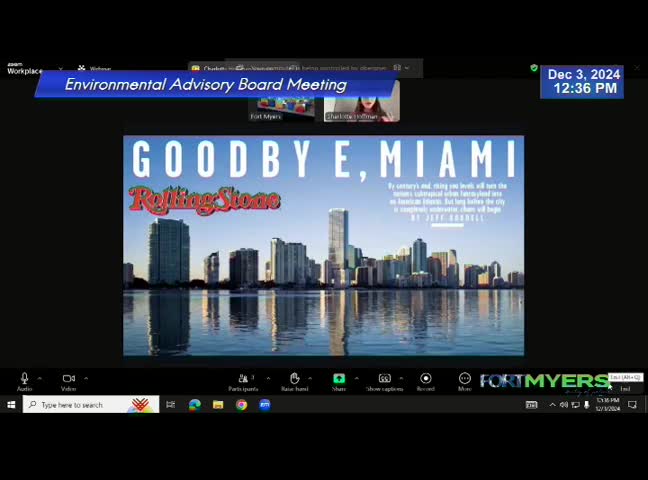Miami pioneers 3D printed living seawalls to combat flooding and enhance marine habitats
December 03, 2024 | Fort Myers City, Lee County, Florida
This article was created by AI summarizing key points discussed. AI makes mistakes, so for full details and context, please refer to the video of the full meeting. Please report any errors so we can fix them. Report an error »

The Fort Myers Environmental Advisory Board convened on December 3, 2024, to discuss innovative solutions for coastal protection amid rising concerns about climate change and its impact on local ecosystems. A significant focus of the meeting was on the introduction of 3D-printed living seawalls, a project aimed at enhancing both community resilience and marine biodiversity.
The discussion highlighted the urgent need for effective coastal defenses in light of increasing sea levels and storm surges, particularly in regions like Miami, where traditional seawalls have been criticized for their environmental impact. The speaker emphasized that conventional seawalls often lead to a significant loss of biodiversity, with studies indicating that up to 45% of marine life can be lost within a year of installation. This stark reality has prompted a shift towards more sustainable solutions.
The proposed 3D-printed living seawalls are designed to mimic natural coastal habitats, such as mangrove forests, thereby providing essential marine habitats while maintaining structural integrity. The innovative production process allows for rapid construction, with the ability to print a seawall panel in just one hour, significantly reducing the waiting time for installation, which currently can extend up to two years in Florida.
Key advantages of the living seawalls include their ability to dissipate wave energy more effectively than traditional flat walls, potentially reducing overtopping and erosion. The design incorporates features that promote marine life attachment, enhancing biodiversity and improving water quality. The speaker noted that these seawalls have a lower carbon footprint compared to traditional concrete options, further aligning with environmental sustainability goals.
The board also discussed the potential for these living seawalls to qualify for various funding opportunities, including FEMA grants, which could support broader implementation across the region. The conversation underscored the importance of collaboration with local engineers and permitting agencies to ensure that these innovative solutions can be integrated into existing coastal management frameworks.
In conclusion, the meeting highlighted a proactive approach to addressing the challenges posed by climate change through the adoption of cutting-edge technology in coastal infrastructure. The introduction of 3D-printed living seawalls represents a significant step towards protecting both communities and marine ecosystems, setting a precedent for future environmental initiatives in Fort Myers and beyond.
The discussion highlighted the urgent need for effective coastal defenses in light of increasing sea levels and storm surges, particularly in regions like Miami, where traditional seawalls have been criticized for their environmental impact. The speaker emphasized that conventional seawalls often lead to a significant loss of biodiversity, with studies indicating that up to 45% of marine life can be lost within a year of installation. This stark reality has prompted a shift towards more sustainable solutions.
The proposed 3D-printed living seawalls are designed to mimic natural coastal habitats, such as mangrove forests, thereby providing essential marine habitats while maintaining structural integrity. The innovative production process allows for rapid construction, with the ability to print a seawall panel in just one hour, significantly reducing the waiting time for installation, which currently can extend up to two years in Florida.
Key advantages of the living seawalls include their ability to dissipate wave energy more effectively than traditional flat walls, potentially reducing overtopping and erosion. The design incorporates features that promote marine life attachment, enhancing biodiversity and improving water quality. The speaker noted that these seawalls have a lower carbon footprint compared to traditional concrete options, further aligning with environmental sustainability goals.
The board also discussed the potential for these living seawalls to qualify for various funding opportunities, including FEMA grants, which could support broader implementation across the region. The conversation underscored the importance of collaboration with local engineers and permitting agencies to ensure that these innovative solutions can be integrated into existing coastal management frameworks.
In conclusion, the meeting highlighted a proactive approach to addressing the challenges posed by climate change through the adoption of cutting-edge technology in coastal infrastructure. The introduction of 3D-printed living seawalls represents a significant step towards protecting both communities and marine ecosystems, setting a precedent for future environmental initiatives in Fort Myers and beyond.
View full meeting
This article is based on a recent meeting—watch the full video and explore the complete transcript for deeper insights into the discussion.
View full meeting